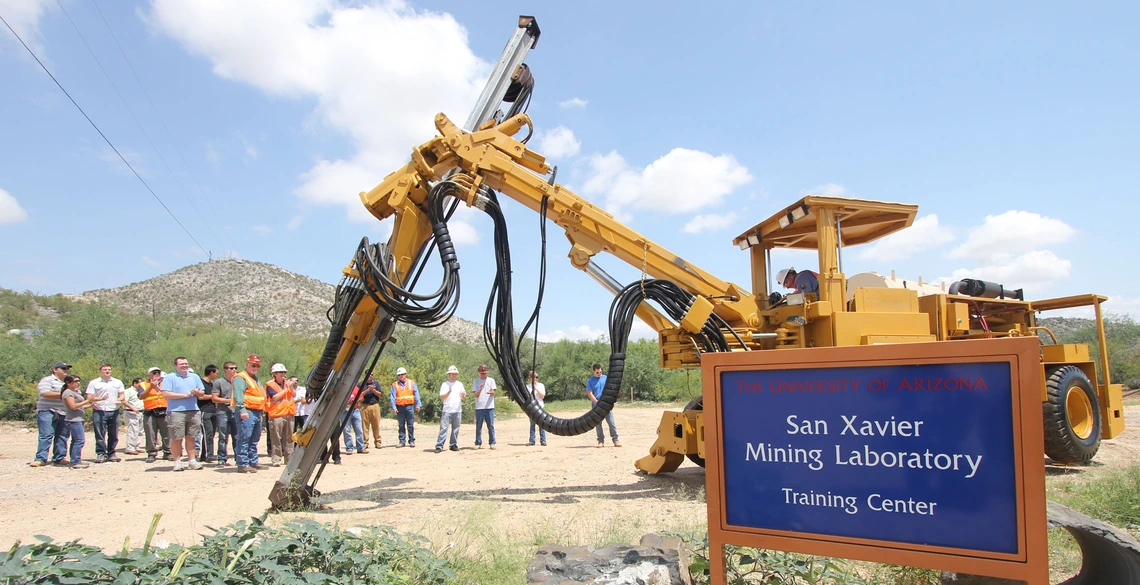UA Mining Lab Gets Jumbo Gift from Industry Partners
Asarco and Atlas Copco are providing much more than a rebuilt, repainted drill jumbo -- the gift includes parts, service and training to keep the rig safe and operational. (Photo: Pete Brown)

After: One happy rig, restored to its former showroom glory by Asarco service engineers and ready for a new lease on life at the San Xavier mine.
Mining engineers at the UA College of Engineering are the proud new owners of a 40-foot-long monster drilling rig, thanks to industry partners Asarco and Atlas Copco.
The diesel-powered mobile drilling vehicle, known in the mining industry as a "drill jumbo," will be used by mining engineering students to carve out new tunnels at the UA's San Xavier Underground Mining Laboratory, about 23 miles south of Tucson, Ariz.
The drill jumbo was formally donated to the San Xavier Mine Aug. 11 by Asarco president Manuel Ramos, and Steve Holmes, UA mining engineering alumnus and general manager at Asarco's copper- and silver-producing Ray mine near Kearny, Ariz.
Alumnus Vision
Asarco operated the drill jumbo for more than 10 years at the Ray mine, but the rig fell into disrepair and languished in the mine's truck yard for a few years until Holmes decided it was a waste of good equipment and could be of benefit his alma mater.
To refurbish the drill jumbo and make it once again fit for use, Holmes enlisted the help of the Tucson division of mining services company Atlas Copco, whose service engineers train Asarco's equipment operators and keep the Ray mine's fleet of heavy duty vehicles safe and operational.
"The drill was sitting around for a while, so I saw a use for it," Holmes said during the donation ceremony at the San Xavier Mine.
Bob Evans, truck shop general supervisor at Asarco Ray mine, supervised the drill's refurbishment. Evans noted that even though this 1997 rig isn't fully computerized like the newest models, which require operators to train in a simulator much like pilots, it's still a complex piece of equipment that will provide students with invaluable operational experience. "Students get a head start on training," Evans said. "Even the latest hi-tech models use hydraulic and mechanical systems."
Atlas Copco is providing much more than a rebuilt, repainted drill jumbo, however. The company will also provide parts, service and training to keep the rig safe and operational. Michelle Pettit, Atlas Copco service administrator, said: "Our mechanics have worked tirelessly to make the drill look like it just came off the factory floor. It doesn't end today with the donation of the drill, and it's so exciting knowing how this will affect students' futures."
University Distinguished Professor Mary Poulton, head of the department of mining and geological engineering and director of the UA's Lowell Institute for Mineral Resources, described it as a "tremendous gift."
Ready to Roll
She already has the drill's first project lined up: blasting a bigger "decline," or inclined access road, into the San Xavier mine. "This drill jumbo will help us build a new decline in the mine, which we couldn't do with our existing drills," Poulton said. "It will open up lots more research opportunities for students. We need a bigger opening to do better research using more modern equipment, including autonomous mine vehicles and advanced communication systems."
The drill's function is to bore holes in the rock face, into which explosives are packed, and then detonated, blasting a tunnel into the rock. Drilling and blasting at San Xavier is currently a slow process. Mining engineers use manually operated jackleg drills to bore holes no more than 6 feet into the rock face, while standing firmly on the ground, which limits tunnel size and progress.
The new jumbo will drill bigger, deeper holes much faster so more explosive can be packed in, and more rock removed. The tunnel created by the jumbo is 14 feet in diameter, which will allow access by larger mine vehicles and create much needed extra capacity for expanded training. "We're running out of space to train people," Poulton said. "It looks like Swiss cheese down there."
Poulton and Holmes have no doubt that this industry-university partnership makes the San Xavier mine a leader in education, training and research. "The vision is for San Xavier to be a world-class lab, unique to the UA," Holmes said. "No other mine has this much potential, but support is needed from industry and alumni."
Poulton concurred: "One of the best measures to assure a great program is passion," she said. "Atlas Copco, Asarco and others in the industry, plus faculty and students, have that. Which is why we have such a great program."
Inventory Check
And Holmes is not done yet. He wants other mining industry companies to help the San Xavier mine, and plans to urge them to check their inventories to see what they really do and do not need.
The Henry G. "Hank" Grundstedt San Xavier Underground Mining Laboratory has been operated by the department of mining and geological engineering since 1958 and owned since 1975. The mine is on 90 acres of land, with underground workings to a depth of 250 feet on four levels. It is the only mining laboratory in the nation with a working vertical shaft.
The facility is used to complement courses in mining and geological engineering through semester projects and laboratory exercises. Students normally work one 8-hour shift per week to develop hands-on experience and get exposure to some of the latest technical advances in mining and excavation.
The San Xavier Underground Mining Laboratory is also used as a training resource by federal and state agencies as well as organizations involved in underground research, tunnel safety, and mine rescue. Tours and community activities are also conducted to educate the general public on the importance of the mineral and construction industries.

